Lecture 5 C. Retrograde motion & Epicycles
 Q. What is retrograde motion?
Q. What is retrograde motion?
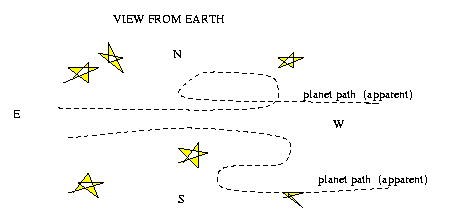
A: The apparent "backward" motion of a planet, as seen in the Earth's sky.
 ignore difference in paths above for now: point is, planets usually move W to E, which
we call "prograde" or "direct," then appear to move E to W, or "backward" from normal motion,
before resuming W to E motion
ignore difference in paths above for now: point is, planets usually move W to E, which
we call "prograde" or "direct," then appear to move E to W, or "backward" from normal motion,
before resuming W to E motion
the key word here is apparent -- in fact, NO actual backward motion occurs
this is most easily seen from the Sun -- remember that things really do orbit the Sun,
because the Coperinican/Heliocentric picture is the correct one!
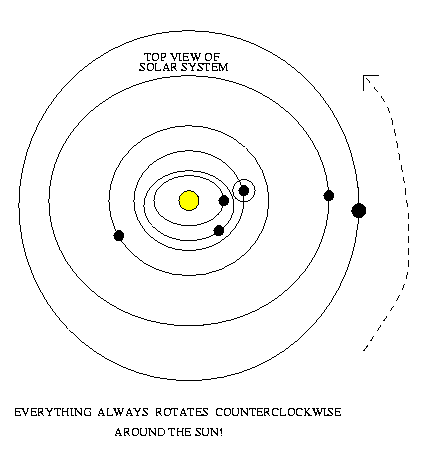 because planets always rotate W to E around the Sun, and everything orbits the Sun,
the view from the Sun doesn't even show apparent retrograde motion!
because planets always rotate W to E around the Sun, and everything orbits the Sun,
the view from the Sun doesn't even show apparent retrograde motion!
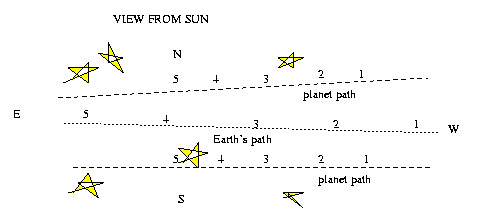 (numbers in this figure are meant to correlate planets' positions in time; points 1-5 would
all fall near or within points B-C-D in figure 1.11 in the text, on p. 27)
retrograde motion is just a trick of perspective, because we're on an orbiting planet
looking at other orbiting planets
(numbers in this figure are meant to correlate planets' positions in time; points 1-5 would
all fall near or within points B-C-D in figure 1.11 in the text, on p. 27)
retrograde motion is just a trick of perspective, because we're on an orbiting planet
looking at other orbiting planets
 On the other hand, from the WRONG geocentric viewpoint of Ptolemy,
with everything orbiting Earth, one would believe any backward (E to W) motion to be actual,
not just apparent!
On the other hand, from the WRONG geocentric viewpoint of Ptolemy,
with everything orbiting Earth, one would believe any backward (E to W) motion to be actual,
not just apparent!
so Ptolemy invented epicycles so planets would actually move forward sometimes & backwards
others:
- normal motion was taken care of by orbiting around the deferent, a large circle
on which the epicycle always rotated counterclockwise
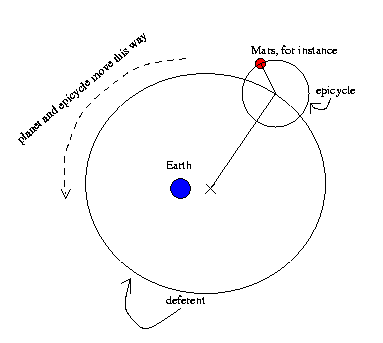
- retrograde motion was imagined to occur when the planet was on the inner part of the
epicycle, making it move in the backward from the usual direction of the epicycle around the deferent
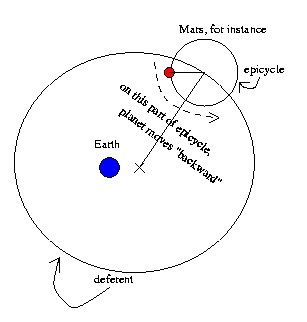
- this can generate planet paths that look confusingly similar to the one at the head of this
section, hence the acceptance of Ptolemy's model!
 ASIDE: Q: Hey, what's the difference between the two planet paths in this
sections first picture?
ASIDE: Q: Hey, what's the difference between the two planet paths in this
sections first picture?
A: Only our perspective on them:
- the variation of the ecliptic as seen from Earth due to our
planet's tilt -- the same thing that causes season's -- means we're seeing planets' paths from
different angles as time passes.
- also, though all planets orbit roughly in the ecliptic, there is a slight spread in the
inclination of the orbits
 Q. What is retrograde motion?
Q. What is retrograde motion?

 Q. What is retrograde motion?
Q. What is retrograde motion?

 ignore difference in paths above for now: point is, planets usually move W to E, which
we call "prograde" or "direct," then appear to move E to W, or "backward" from normal motion,
before resuming W to E motion
ignore difference in paths above for now: point is, planets usually move W to E, which
we call "prograde" or "direct," then appear to move E to W, or "backward" from normal motion,
before resuming W to E motion


 On the other hand, from the WRONG geocentric viewpoint of Ptolemy,
with everything orbiting Earth, one would believe any backward (E to W) motion to be actual,
not just apparent!
On the other hand, from the WRONG geocentric viewpoint of Ptolemy,
with everything orbiting Earth, one would believe any backward (E to W) motion to be actual,
not just apparent!


 ASIDE: Q: Hey, what's the difference between the two planet paths in this
sections first picture?
ASIDE: Q: Hey, what's the difference between the two planet paths in this
sections first picture?